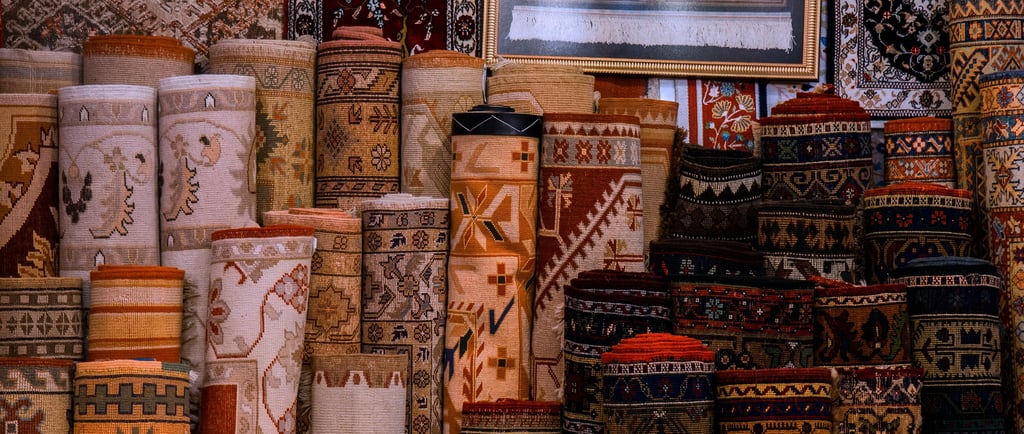Why Handmade Rugs Are the Heart of Modern Homes: The Ultimate Guide Backed by Numbers, Science, and Indian Heritage
Discover the 2025 handmade rug revolution - market trends, health benefits, and design styles shaping the future of artisanal carpets. Explore Bhadohi’s legacy, sustainable craftsmanship, and why handmade rugs are the ultimate blend of tradition, wellness, and timeless style.
7/17/20253 min read


The Handmade Rug Revolution in 2025
Handmade rugs are having a moment—a global moment. Far from being just floor coverings, they’ve become symbols of artistry, sustainability, and heritage.
In 2025, the global handmade rug market is valued at $3.5 billion and is projected to soar to $5.2 billion by 2033, growing at a healthy 4.5% CAGR. The broader carpets and rugs industry is an even bigger giant worth $94.91 billion today, and set to hit $153.39 billion by 2034.
India: The Beating Heart of the Handmade Rug Industry
India is one of the strongest pillars of this global growth. The Indian handmade carpet and rug market alone is worth $56.4 million in 2024, and is expected to reach $89.2 million by 2030, growing at an impressive 8% CAGR.
And then there’s Bhadohi, the “Carpet Capital of India.” Your hometown contributes 50% of the country’s handmade carpet exports, making it a powerhouse of artistry and tradition.
What’s Driving the Boom in Handmade Rugs?
1. Rising Demand for Artisanal Craftsmanship
In 2022, U.S. home furnishings sales hit $102 billion, showing consumers’ growing appetite for quality, story-rich products.
Younger buyers and design-conscious urban households increasingly choose unique, non-mass-produced pieces that reflect personal style and cultural heritage.
2. Sustainability & Wellness in the Spotlight
Handmade rugs are crafted from natural fibers like wool, cotton, and jute eco-friendly, renewable, and biodegradable.
52.86% of India’s handmade rug revenue comes from woollen products, prized for durability, insulation, moisture resistance, and eco-friendliness.
Buyers are seeking low-carbon, fair-trade, chemical-free options, proof that eco-consciousness isn’t a trend; it’s the new normal.
3. Proven Health Benefits
Scientific studies show that handmade rugs can actually improve health and home comfort:
Better air quality: Wool rugs naturally purify air for up to 30 years.
Allergy-friendly: Natural fibres trap less dust than synthetics, reducing asthma and allergy triggers.
Thermal & sound insulation: Keeps homes quieter and warmer.
Joint & bone support: Natural materials regulate moisture and temperature beneficial for skeletal health.
4. Heritage, Economy & Longevity
Handmade rugs can last decades—even generations, often gaining value over time.
Every purchase supports artisans, preserves centuries-old skills, and fuels local economies in GI-tagged hubs like Bhadohi, Jaipur, and Srinagar.
2025 Handmade Rug Design Trends
Neutral palettes + bold accents: Beige, grey, and cream bases with pops of deep blue, green, or terracotta.
Vintage revival: Persian and Art Deco classics with a modern twist faded, “lived-in” charm meets oversized patterns.
Sustainable fibers: Local, renewable, and planet-friendly materials are in demand.
Handmade vs. Machine-Made Rugs
Materials
Handmade: Natural fibers such as wool, cotton, jute, and silk.
Machine-made: Mostly synthetic, petrochemical-based fibers.
Durability
Handmade: Can last decades or even generations.
Machine-made: Typically needs replacing after just a few years.
Health Benefits
Handmade: Hypoallergenic, antibacterial, helps regulate air, sound, and moisture.
Machine-made: May trap dust and allergens, can emit VOCs.
Environmental Impact
Handmade: Low carbon footprint, eco-friendly processes, fair trade artisan work.
Machine-made: High energy consumption, chemical use, and landfill waste.
Economic Impact
Handmade: Supports local artisans, preserves traditions, pays fair wages.
Machine-made: Primarily benefits factories with minimal artisan involvement.
Bhadohi & Indian Mastery by the Numbers
50% of India’s handmade carpet exports come from Bhadohi.
40% of the world’s handmade carpets are from India.
Domestic Indian market growth: up to 10% CAGR for woven carpets and 9.9% for cotton rugs.
How to Choose the Perfect Handmade Rug in 2025
Assess the Space: Neutral base + bold accents for versatility.
Think Sustainability: Opt for wool, cotton, or jute.
Check Authenticity: Look for GI tags (e.g., Bhadohi), hand-tied knots, and fair-trade certification.
Prioritize Health: Natural fibers and chemical-free dyes for a safer home.
Conclusion: More Than Just a Floor Covering
A handmade rug is art you can walk on, a blend of tradition, sustainability, wellness, and style. Choosing one in 2025 means uplifting your living space, empowering artisans, and investing in a greener planet.
With Bhadohi leading the charge, every handmade rug you bring home carries centuries of skill and the spirit of Indian craftsmanship. Let your floors tell a story—one that’s good for you, the maker, and the world.
We weave stories, not just rugs. For 30+ years, we’ve helped brands and designers around the world bring handmade beauty to modern spaces.
Drop Your Email – We’ll Reach Out
+91 9580328504 | 7706919786
Evergreen Carpets
Bhadohi, Uttar Pradesh, India
© 2025. All rights reserved.
info@evergreencarpets.in
quick access
